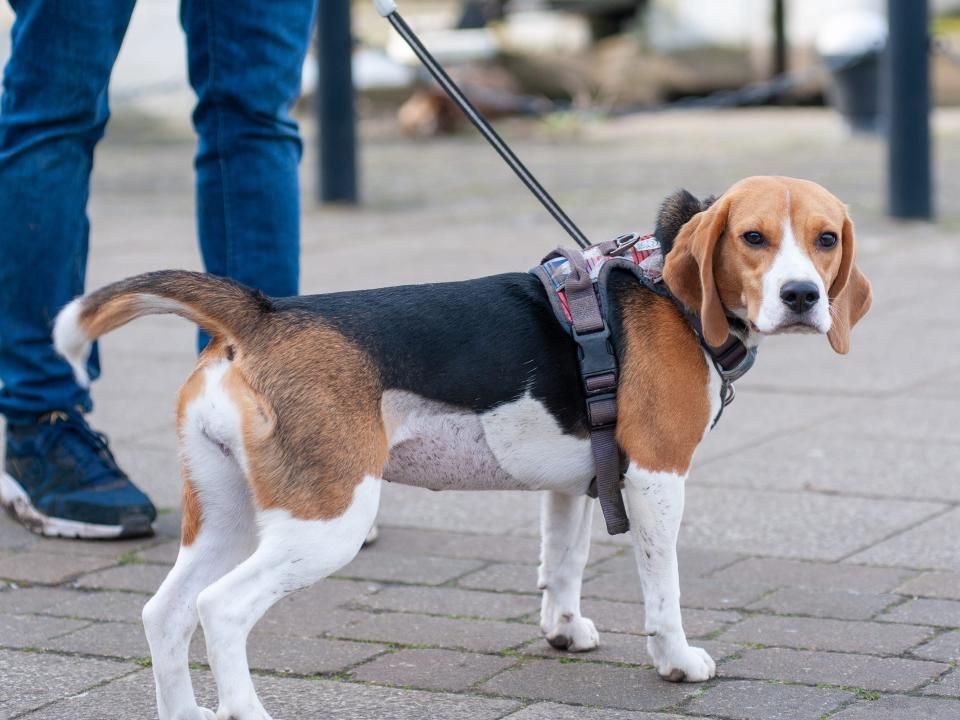Veterinarians share 10 things you should never do when taking your dog on a walk
Insider asked veterinarians to share the most common dog-walking mistakes pet owners make.
Ignoring weather conditions and approaching unfamiliar dogs on a walk can be unsafe for your pet.
Using the wrong kind of restraints or collar can be dangerous and may even injure your dog.
Though dogs need regular exercise to stay happy and healthy, a fun walk can quickly become an uncomfortable or dangerous experience.
Here are a few common mistakes dog owners make when taking their pets for a walk, according to veterinarians:
You shouldn't approach unfamiliar dogs without speaking to the owner

Veterinarian Jamie Richardson, medical chief of staff at Small Door Veterinary, told Insider that approaching unfamiliar dogs without asking their owners could lead to a dangerous situation.
"No matter how friendly your dog is, you don't know how the other dog might react," said Richardson. "It's never safe to let your dog greet another dog unless you've checked with their owner."
Even friendly dogs may bark, snarl, or bite if they feel uncomfortable, so if either pet seems nervous or shy, it's best to separate them.
Avoid walking your dog on de-iced sidewalks or streets
Snowy and icy weather can mean that chemical de-icing agents or rock salt have been distributed on streets and sidewalks.
"These de-icers can cause burns on your dog's paws," said Richardson. "The chemicals can also lead to sickness or potential poisoning if your dog licks their paws clean after the walk."
Consider equipping your dog with booties if you can't avoid pavement treated with chemicals or rock salt.
Using an extendable leash can be unsafe

Though you may prefer using extendable leashes to give your pup more freedom, this can actually be dangerous for pets and owners.
"Extendable leashes don't give you full control over your dog," said Richardson. "When a dog runs into an unsafe situation, like traffic, many owners instinctively grab the cord and receive serious burns or deep cuts."
Similar injuries can occur if the cord becomes twisted around an owner's legs when a dog runs away.
Richardson advised using a regular, non-retractable leash with a 6-foot maximum length, especially when walking in the city.
Don't tug on the leash when your dog pulls
Though it may seem natural to tug on a dog's leash when they pull away, this isn't an effective way to train your pet to walk well.
"Counterintuitively, pulling on the leash actually causes your dog to pull harder in order to stay balanced and not fall backwards," said Richardson.
Instead, Richardson recommends standing still and waiting for your dog to look back at you.
"When they look back, reward your dog with praise or treats and start walking in your intended direction," he said.
Letting a dog off the leash inappropriately is a major mistake

Richardson said recall training — when an owner teaches a pet to return when called — can take a long time to master and may not work during an emergency or if a dog is distracted.
"Owners should never let their dog off the leash unless they are 100% confident the dog will always come back," said Richardson. "Even then, only let them off the leash in safe areas like fenced parks or dog runs."
Don't forget to reward good walking behavior
Just like teaching your dog to sit or stay, training your pet to walk well is an important skill.
"Many owners forget that each walk can be a training opportunity to instill good walking habits," said Richardson. "When your dog displays good behavior, immediately praise them and give a treat."
Rewarding your dog for good walking etiquette will help them associate walking calmly with praise.
Never use a choke or prong collar to prevent pulling
Choke and prong-style restraints — known as aversive collars — use discomfort to teach dogs certain behaviors by tightening or pinching the skin when they pull on the leash.
"These collars rarely work and can actually cause significant harm to your dog," said Richardson.
Richardson recommends using a head halter or headcollar, which steers a dog's head when they pull and discourages this behavior while protecting the pet's neck.
Walk your small-breed dog in a harness instead of a neck collar

Small breeds such as chihuahuas, terriers, and miniature dachshunds should not wear traditional neck collars.
"A small-breed dog should always be walked in a harness rather than a collar to avoid damaging their sensitive tracheas,' said Richardson.
You can ask your vet about which kind of restraint is best for your particular dog.
Don't ignore weather conditions
Veterinarian Heather Venkat of VIP Puppies told Insider that one common mistake dog owners make is not adjusting the length of a walk based on the weather.
"An owner might be used to walking their dog for 30 minutes every day, but extremely hot or cold weather could make them sick or injured," said Venkat.
Walk times should be reduced and routes should be changed in very hot or cold weather to avoid hot pavement or slippery ice.
Don't forget to bring dog-waste bags
Besides earning you dirty looks from passersby, not using waste bags to clean up after your dog can be unsafe to others.
"When you leave a dog's messy waste on a neighbor's lawn or elsewhere in the environment, it can attract unwanted bugs and wildlife," said Venkat.
Animal waste can also carry bacteria that may harm passing children or pets. Venkat suggested keeping waste bags attached to your pet's leash or harness to avoid forgetting them.
Read the original article on Business Insider

 Yahoo News
Yahoo News 
